Which yoga asanas can I practice during periods? Is it ok to do inversions at that time of the month? Are twisting postures allowed? These are common questions that come up on the subject of yoga during periods and in this article, I will share my recommendations on how we should approach our yoga practice during these crucial days of the month.
Why Yoga for Periods
A healthy menstrual cycle is essential for a woman’s well-being. However, the modern-day stressful lifestyle with its busy schedules, endless timelines, erratic hours, artificial lights and high-pressure environment can interfere with the natural biological rhythm. Ironically, all the advancement in nutrition, medicine, and technology has resulted in women going through many more menstrual cycles today than we did historically. Girls are starting to menstruate earlier due to better nutrition, women are having fewer pregnancies and shorter lactation periods which means we are having more monthly periods in one lifetime than before.
This means more monthly instances of mood swings, hormonal changes and a higher probability of imbalances to occur. To counter this, incorporating a holistic yoga practice into our daily life is exceptionally beneficial. It is excellent for relaxation, has a positive effect on the hormones and restores balance to body and mind as per our individual needs. Most importantly it helps with stress management which is important as long-term stress adversely impacts the reproductive system. Generally, I do not recommend isolating individual postures and practicing just one or two of them. A complete practice with asanas, pranayama, and meditation is far more beneficial. But during periods, it can be helpful to focus on just a few and give our body the much-needed moments or relaxation and stillness. Here are five restorative yoga poses that can be particularly helpful during periods:
#1 Marjariasana-Bitilasana or Cat-Cow Pose
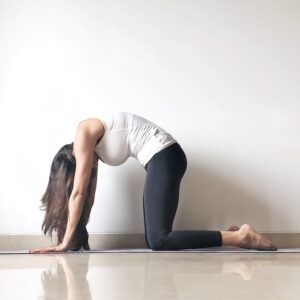
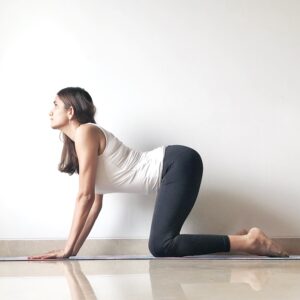
It is one of the gentlest movements for the spine and is very therapeutic for the body. However, it is essential to do these slowly and mindfully in rhythm with the breath. It is excellent to activate the spine and gives relief from period cramps.
1. Start in a tabletop position resting on your hands and knees
2. Make sure that knees are directly under the hips and wrists are precisely under the shoulders.
3. Gentle inhale as you look up and sink the belly towards the floor
4. As you exhale drop the head down, bring the chin to chest and round the back as much as possible.
5. Do this for six to nine rounds and rest back in child pose with wide knees once done.
#2 Nikunj Asana or Modified Child Pose
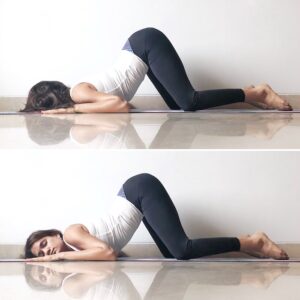
This posture has a very cooling effect and is especially helpful for cramps in the lower belly. It relieves some pressure from the uterus and also calms us down as the heart is close to the ground. By comfortably inverting the body, we reduce stress on the lower back and the uterus.
1. Start in a tabletop position on all fours as described above.
2. Bend the elbows and bring the chest to the ground turn head to face one side. Hold for 6 to 9 breaths
3. Turn head to face the opposite side and hold again for 6 to 9 deep breaths.
4. Slowly get up and sit in Vajrasana for a few breaths.
3. Ardha Upavishtakonasana or Modified Seated Wide legged forward bend
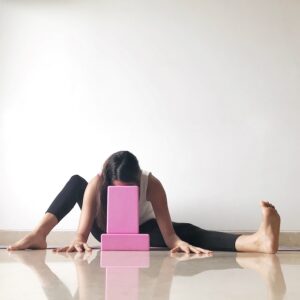
Upavishtakonasa is excellent to bring awareness to the groin area and improves the circulation thereby gently stretching the surrounding tissues. The stretch should be gentle and a pillow, bolster or block can be used to relax into the pose without going too deep.
1. Sit on the mat with legs straight in front of you
2. Bend the left knee and widen the legs slightly
3. Place a stack of pillows or blocks in front of you and lean forward as much as possible.
4. Hold for 6 to 9 breaths, then change legs.
5. Release and come into a seated cross-legged position for a few breaths
4. Supta Baddhakonasana or Reclining Bound Angle Pose.
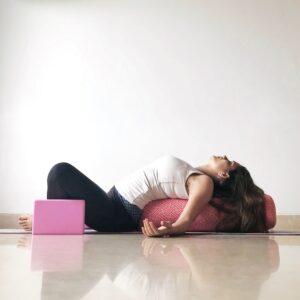
It is another restorative yoga posture that is great for relieving symptoms of periods especially mood swings and erratic temperament.
1. Place a bolster on the mat and sit directly in front of it
2. Join the soles of your feet together like in cobbler pose or cross your legs
3. Lie down on the bolster and release your arms on either side
4. Rest in this position for 1 to 3 minutes.
If there’s discomfort in the knees, use blocks or pillows to support them. Slowly build capacity to stay in this posture for up to 5 minutes.
5. Yoga Nidra or Shavasana.
Yoga Nidra is a beautiful practice of systematic relaxation and one of the few yoga techniques for menstrual problems which have been backed by research. In a 2013 study by King George’s Medical University in Lucknow, Yoga Nidra was administered daily for 35-40 mins day, five times a day over six weeks for 150 women with menstrual irregularities. It was found extremely beneficial in fixing hormonal imbalances including painful or irregular menstruation as well as heavy or scanty flow during periods.
Yoga Nidra is a guided meditation technique it is more effective when led by a trained teacher. These meditations are also available through reputed yoga schools and centers across the country. As an alternative, Shavasana can be practiced for 5 to 10 minutes, completely relaxing the body and mind.
Conclusion
Periods are a great time to build body awareness as we are generally more sensitive. The focus should be on restoring and relaxing, gently opening the pelvic area and encouraging the flow of waste material out of the body. We should certainly follow our intuition and listen to the body’s demands during this time as nothing can be a better guide. However it is important to remain aware that this monthly detox cycle is a double edged sword – it can help us cleanse and let go of everything that is no longer needed or it can get blocked and fester and create severe imbalances. That is why I lean towards avoiding poses that invert, compress, or agitate the uterus physically. Which means skipping postures like dhanurasana, shalabhasana, shirshasana etc. during these days. Mild twists can be done if the body feels up to it but should be avoided in case of excess bleeding. And never force the body or push it to do what it is not ready for because so and so asana or exercise ‘is good to do’. Listen to what your body wants and go with the flow!
Note: I wrote this article for the Stayfit Magazine and it was published in their Sep 2018 edition.






